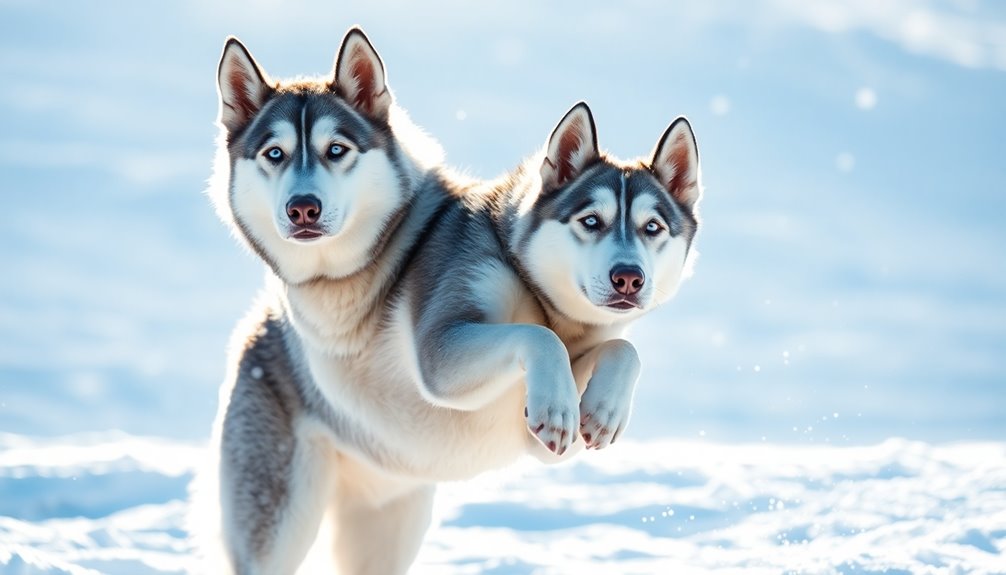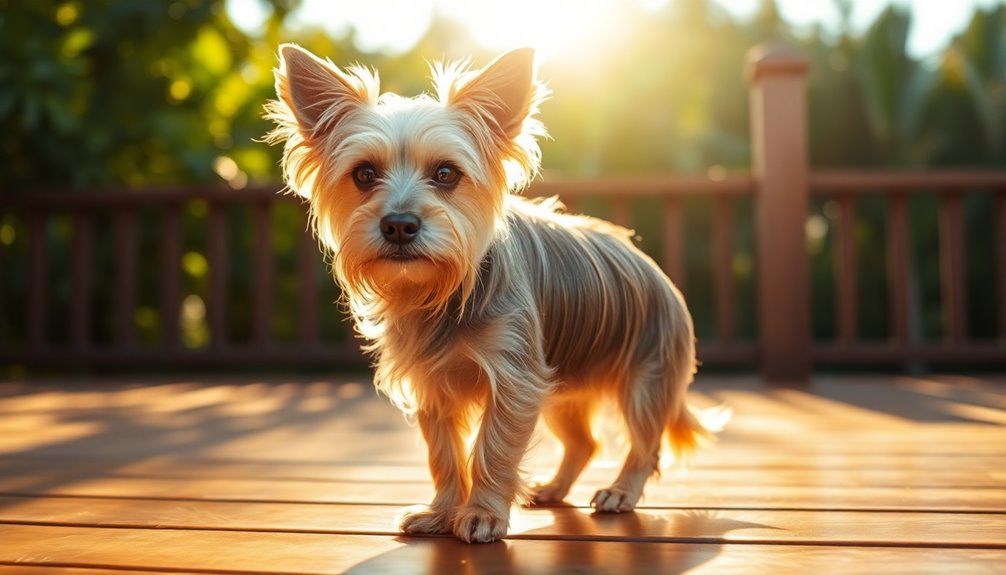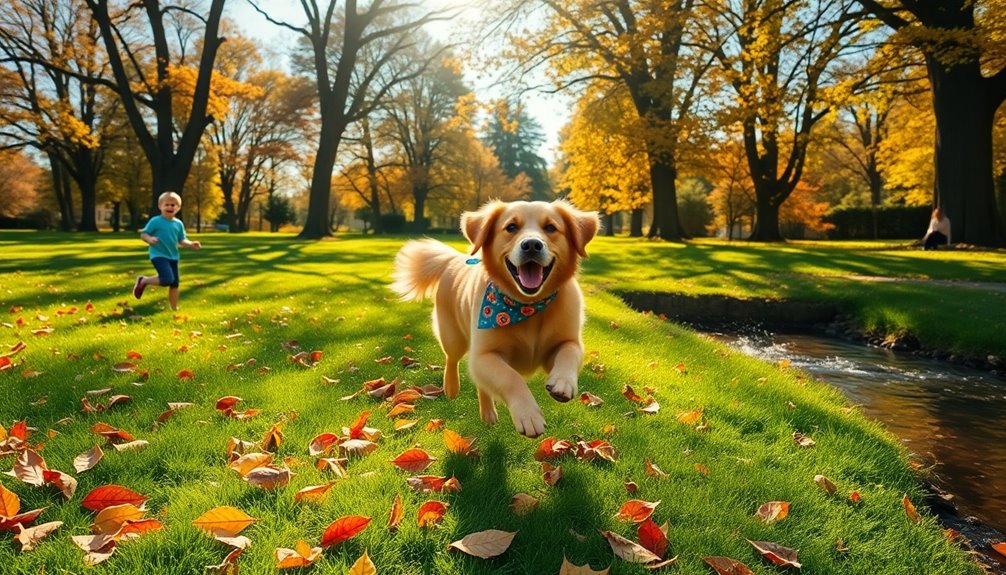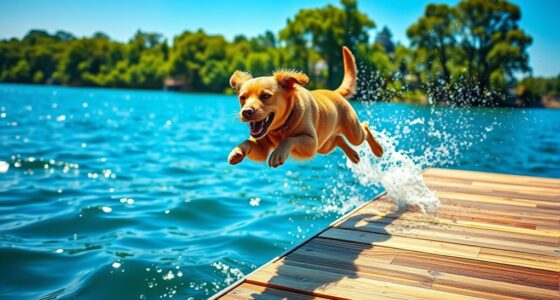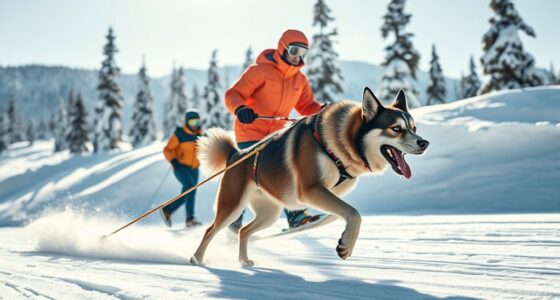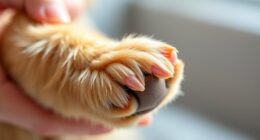Siberian Huskies are truly stunning and energetic sled dogs, making them incredible companions for active people like you. With their captivating blue or mixed-colored eyes and striking fur, they're hard to resist. Huskies thrive on exercise, needing at least 1-2 hours daily to keep them happy and healthy. Their playful and mischievous personalities shine in family settings, but they can be stubborn, so consistent training is key. They have a rich history as sled dogs and often communicate through distinctive howls. Want to uncover more about their unique traits and care needs? Keep exploring!
Key Takeaways
- Siberian Huskies are known for their striking appearance, featuring erect ears and captivating blue or brown eyes.
- Originally bred by the Chukchi people for sled pulling, Huskies have been integral to Arctic survival for thousands of years.
- They require a minimum of 1-2 hours of daily exercise to maintain their physical and mental health.
- Huskies thrive in cooler climates and should be protected from extreme temperatures, needing ample space for movement.
- Positive reinforcement training and early socialization are crucial for developing well-adjusted and obedient Huskies.
Introduction
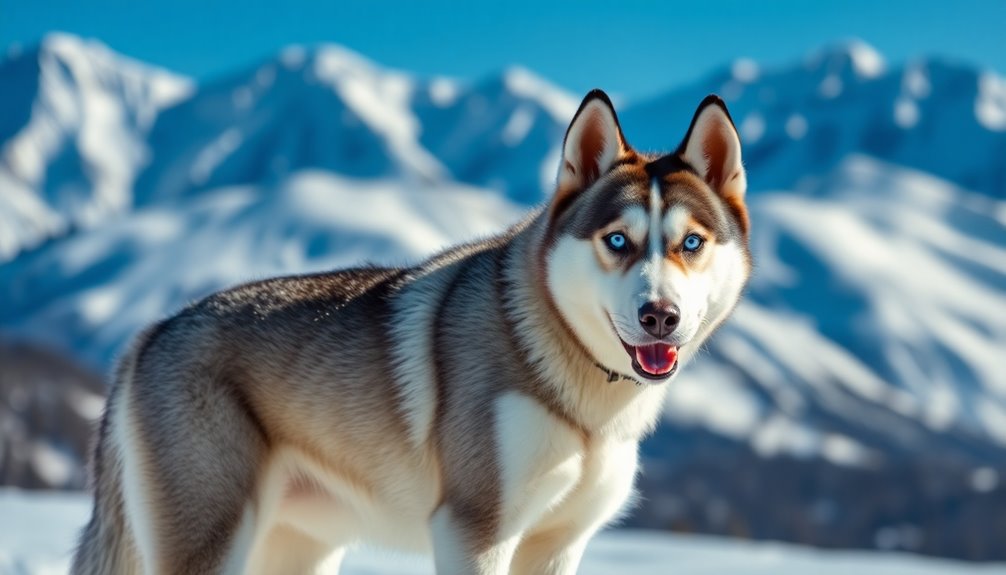
If you've ever seen a Siberian Husky, you know they're striking dogs that capture attention with their stunning appearance and vibrant personalities. Weighing between 35 to 60 pounds and standing 20 to 23.5 inches tall, these dogs boast a powerful build. Their erect ears and captivating eyes—ranging from blue to brown or a combination of both—add to their unique charm.
The Husky's double coat, featuring a dense undercoat and a long, water-resistant outer layer, allows them to thrive in extreme cold. Their fur comes in a variety of colors, from pure white to deep black and every shade in between, often adorned with striking white markings on their legs and chest. The long, bushy tail reflects their playful spirit, which is evident in their friendly nature, especially around children and other dogs. Adaptable to various living situations, Siberian Huskies enjoy companionship and can become destructive if left alone for too long.
However, don't be fooled by their beauty alone; these intelligent and independent dogs require plenty of exercise—at least 40 minutes daily—to keep them happy and well-behaved. With their high energy levels and need for social interaction, Siberian Huskies make wonderful companions for active families.
History and Origin
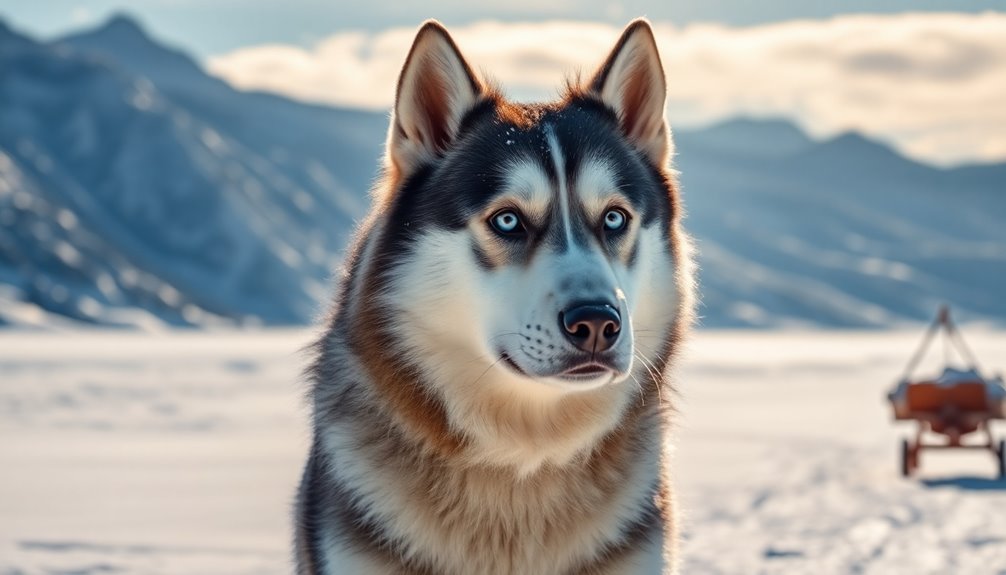
The Siberian Husky traces its roots back to Northeast Asia, where the Chukchi people bred them over thousands of years. You'll find that these dogs were essential for sled pulling and transportation in harsh Arctic conditions. Their remarkable history showcases not just their endurance, but also their deep bond with the people who relied on them for survival. This breed has a history of being bred as all-purpose dogs for the Chukchi tribe, highlighting their versatility and adaptability to various tasks.
Where and when the breed originated
Siberian Huskies have a fascinating history that traces back to Northeast Asia, specifically Siberia, where they were bred by the Chukchi people around 4,000 years ago.
These dogs were developed over a span of 3,000 years, thriving in the harsh Arctic environment. The Chukchi, along with other indigenous peoples like the Koryak, Yukaghir, and Kamchadal, relied heavily on these dogs for survival, utilizing them as all-purpose companions and workers. The Chukchi people depended on these dogs for transportation and fishing across ice and snow.
The breed's name is tied to the geographic region of Chukotka, underscoring its deep connection to Siberia.
The close relationship between the Chukchi people and their Huskies is evident; the dogs were often welcomed into family homes at night, showcasing their integral role in daily life.
Genetic studies suggest that the lineage of the Siberian Husky stretches back over 9,500 years, reflecting the extensive history of selective breeding that shaped their evolution.
Sled Pulling and Transportation
As the Chukchi people faced the challenges of their harsh Arctic environment, they relied heavily on sled pulling for transportation and survival. These remarkable dogs played a crucial role in hunting, fishing, and herding reindeer, ensuring the Chukchi's survival in temperatures that often dipped below -100 degrees Fahrenheit.
Not only did Siberian Huskies pull sleds, but they also served as loyal companions and watch dogs, forming strong bonds with their human teams. Their historical use in military operations showcases their versatility and importance beyond just transportation.
When the Gold Rush hit Alaska, these skilled sled dogs showcased their abilities in the All-Alaska Sweepstakes, where their speed and endurance shone. The 1925 serum run to Nome highlighted their heroism, as they transported life-saving medicine during a diphtheria outbreak.
Their contributions extended to Arctic expeditions, including Rear Admiral Richard E. Byrd's Operation Highjump.
Bred for strength and resilience, Siberian Huskies have evolved through careful breeding to enhance their performance. Today, they're still cherished by competitive and recreational mushers alike.
Not only are they recognized by the American Kennel Club, but they also maintain a special place in hearts worldwide, adapting effortlessly to various climates.
Physical Characteristics
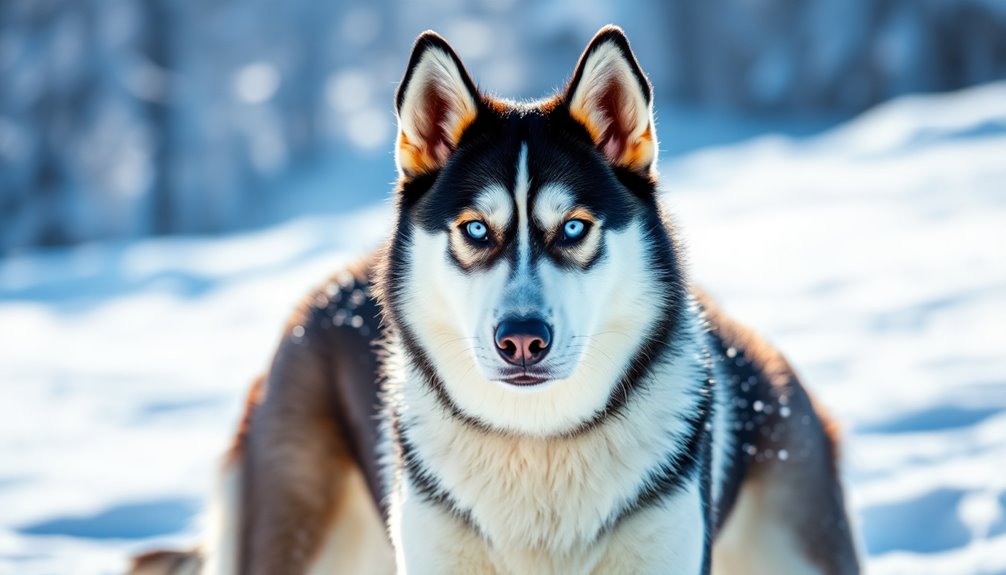
When you see a Siberian Husky, their size and weight can catch your eye—standing 20 to 23.5 inches tall and weighing between 35 and 60 pounds.
Their striking coat, which ranges in colors from white to black, isn't only beautiful but also designed to withstand cold climates. Many different colors of Siberian Huskies can be found, including shades like agouti and red, which often surprise casual observers.
And let's not forget those captivating blue or multicolored eyes that add to their stunning appearance.
Size, weight, and coat details
The stunning Siberian Husky typically stands between 20 and 23.5 inches tall, with males generally being taller than females. Male Huskies usually measure 21 to 23.5 inches at the withers, while females range from 20 to 22 inches. This size reflects breed standards and makes them smaller than Alaskan Malamutes.
When it comes to weight, males typically weigh between 45 and 60 pounds, while females range from 35 to 50 pounds. This weight aligns with breed standards, and you'll find that Huskies generally weigh less than other sledding dogs. They achieve their adult weight by around 1 to 2 years old.
Huskies have a distinctive double coat, which consists of a dense, finely wavy undercoat and a longer, thicker topcoat made of straight guard hairs. This unique coat structure protects them from harsh Arctic winters and helps them stay cool in summer.
During shedding season, you may notice the undercoat thinning out. The coat comes in various colors, including black and white, grey and white, and even rare shades like all white or mostly brown. Patterns can include banding, masking, and spectacles, adding to their stunning appearance.
Striking Blue or Multicolored Eyes
Huskies aren't just known for their impressive size and unique coats; their striking blue or multicolored eyes are equally captivating. The ALX4 gene on chromosome 18 is responsible for this stunning trait, featuring a mutation that affects pigment deposition in the eyes. Unlike other dog breeds or humans, Huskies have a distinct genetic basis for their blue eyes, which can range from deep ocean blue to icy pale shades. Additionally, the genetic diversity within the breed influences the occurrence of blue-eyed Huskies.
You might also notice a variety of eye colors in Huskies, including brown, green, and unique combinations like bi-colored and parti-colored eyes. While blue eyes are the most common, brown results from a recessive gene that can vary in shade. Most Husky puppies start with blue eyes, but you'll see changes occur between 5-8 weeks, stabilizing around 12-16 weeks.
Don't worry about health concerns; blue eyes don't inherently indicate issues. Just ensure you provide proper care to prevent common eye diseases.
Regular vet check-ups and genetic testing can help you stay ahead of any potential problems, allowing your Husky's captivating eyes to shine brightly for years to come.
Temperament and Personality
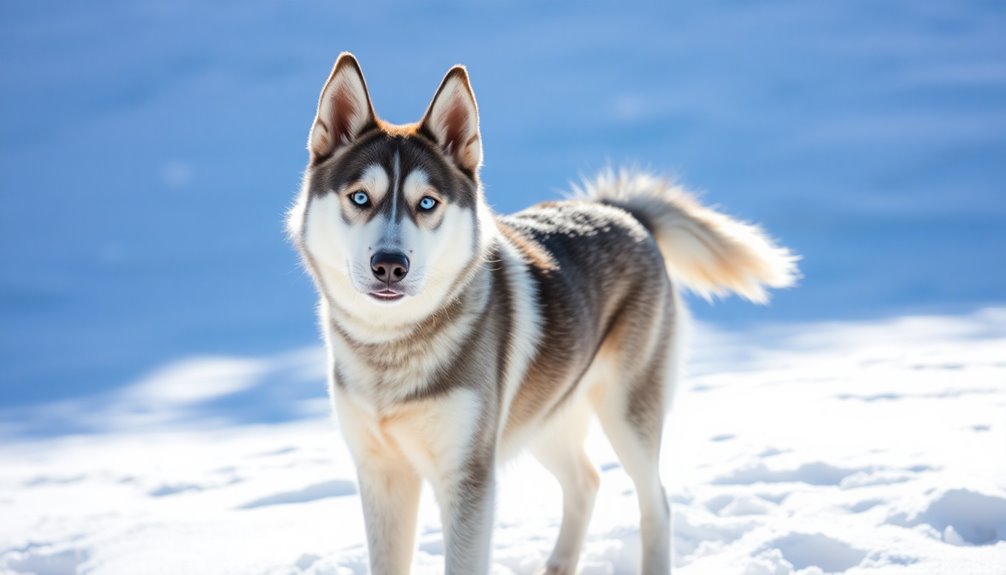
When you welcome a Siberian Husky into your home, you'll quickly notice their playful and mischievous nature. These dogs thrive in family settings and often get along well with other pets, making them great companions. However, their independent spirit can lead to some challenges if they're not properly managed. To ensure a harmonious living environment, it's essential to provide them with significant daily exercise to channel their energy and prevent boredom.
Playful and Mischievous Nature
How can one resist the playful charm of a Siberian Husky? With their high energy levels, these dogs thrive on regular vigorous exercise, making outdoor adventures like running and hiking a joy. They love being part of family activities, showcasing their playful nature.
However, it's essential to provide mental stimulation to prevent boredom-driven destructive behavior. Their mischievous personality shines through in their adventurous spirit. Huskies are known for exploring new environments and can dig or escape if they're under-stimulated. Their independent streak may lead to stubbornness, making training a bit challenging.
While they're social and friendly, they can be aloof at times, and they communicate using a variety of sounds—from howls to chirps. In fact, they are known for their vocal communication, often expressing themselves in unique ways that reflect their emotions.
These dogs enjoy human companionship and typically get along with other dogs, though their prey drive might cause issues with smaller pets. Consistent, positive reinforcement training is vital, as short and engaging sessions keep them interested. Without proper exercise and training, their playful antics can turn into troublesome behaviors.
Suitability for families, individuals, or other pets
With their playful and outgoing personalities, Siberian Huskies make wonderful companions for families, individuals, and even other dogs. Known for their gentle temperament, they bond strongly with family members and are especially great with children. Additionally, their intelligent hybrid nature allows them to learn commands quickly, making training enjoyable.
If you lead an active lifestyle, a Husky can motivate you and your family to engage in outdoor activities. Just remember, they require plenty of exercise to stay happy and healthy. These dogs are known for their high energy levels, so regular outdoor adventures will keep them content.
For individuals, Huskies thrive on human interaction and can be excellent companions for those who enjoy the outdoors. They do need consistent mental and physical stimulation to avoid boredom, but their loyalty and adventurous spirit make them delightful pets.
When it comes to other dogs, Huskies generally get along well, particularly if socialized from a young age. They often prefer the company of another Husky due to their social nature.
However, caution is needed with smaller pets, as their strong prey drive can lead them to chase animals like cats or rabbits. With careful socialization and supervision, introductions can be successful, but it's wise to keep a close eye on them.
Health and Lifespan

When you bring a Siberian Husky into your life, you can expect them to live an average of 12 to 14 years, with some living even longer. However, it's important to be aware of common health concerns that can affect this breed, like hip dysplasia and eye issues. Additionally, regular vet check-ups are advisable to monitor their overall health throughout their lifespan.
Typical lifespan of the breed
Siberian Huskies typically enjoy a lifespan ranging from 12 to 14 years, depending on various factors. With proper care, some Huskies may live up to 15 years, and in optimal conditions, it's possible for them to reach 18 years or more. The average lifespan hovers around 13 to 14 years.
Genetics plays a significant role in determining how long your Husky will live. A balanced diet rich in nutrients, especially omega-3 fatty acids and antioxidants, can contribute to their longevity. Regular exercise is crucial, so aim for at least 40 minutes of physical activity each day to keep them healthy.
Healthcare is another key factor; routine vet check-ups and preventive care help catch any issues early. The environment you provide also impacts their lifespan. Huskies thrive in cooler climates but need protection from extreme heat and cold.
Ensure they've ample space for movement and socialization, as mental health is just as important as physical health.
Common health concerns or genetic predispositions
While Siberian Huskies can enjoy a long lifespan, they're also prone to several health concerns and genetic predispositions that may impact their quality of life.
One significant issue is genetic neurological disorders, such as Shaking Puppy Syndrome and Siberian Husky Polyneuropathy, which can lead to tremors, gait abnormalities, and muscle weakness. Additionally, degenerative myelopathy is a concern, as it causes progressive spinal cord deterioration. It is important to note that Siberian Husky Polyneuropathy typically manifests before the age of two, emphasizing the need for early detection and management.
Orthopedic issues like hip dysplasia are common, impacting joint health and mobility. Corneal dystrophy and follicular dysplasia can also affect their appearance and comfort.
Metabolic issues include urate stones, increasing the risk of urinary complications, and benign familial hyperphosphatasemia, which, while not harmful, may indicate underlying health concerns.
Dental disease often surfaces in Huskies, leading to potential infections that could affect vital organs. They're also susceptible to infections like parvo and distemper.
Lastly, conditions like day blindness and GM1 gangliosidosis add to the breed's health challenges. Being aware of these issues can help you provide better care for your Siberian Husky throughout their life.
Tips for maintaining health and wellness
Maintaining your Siberian Husky's health and wellness hinges on a balanced approach to diet, exercise, and routine care.
Start by feeding a high-quality, age-appropriate diet rich in protein, fat, vitamins, and minerals. Look for dog food with adequate zinc to support their skin and coat health. Avoid overfeeding to prevent obesity, and consider giving frequent small meals to keep their energy levels steady.
Next, ensure your Husky gets at least one to two hours of exercise daily. Engage in brisk walks, hikes, or runs, and incorporate mentally stimulating activities like puzzle toys to prevent boredom. Regular physical activity helps support healthy joints and muscles while reducing behavioral issues caused by pent-up energy. Regular exercise is essential for maintaining both physical and mental stimulation for your Husky.
Don't forget routine veterinary care. Schedule regular checkups to detect potential health issues early, including screenings for hip dysplasia and thyroid function tests.
Regular grooming is also crucial; brush your Husky at least once a week, or daily during shedding seasons, to maintain coat health.
Lastly, always provide access to clean, fresh water to keep them hydrated, especially after exercise or in hot weather.
Care Requirements
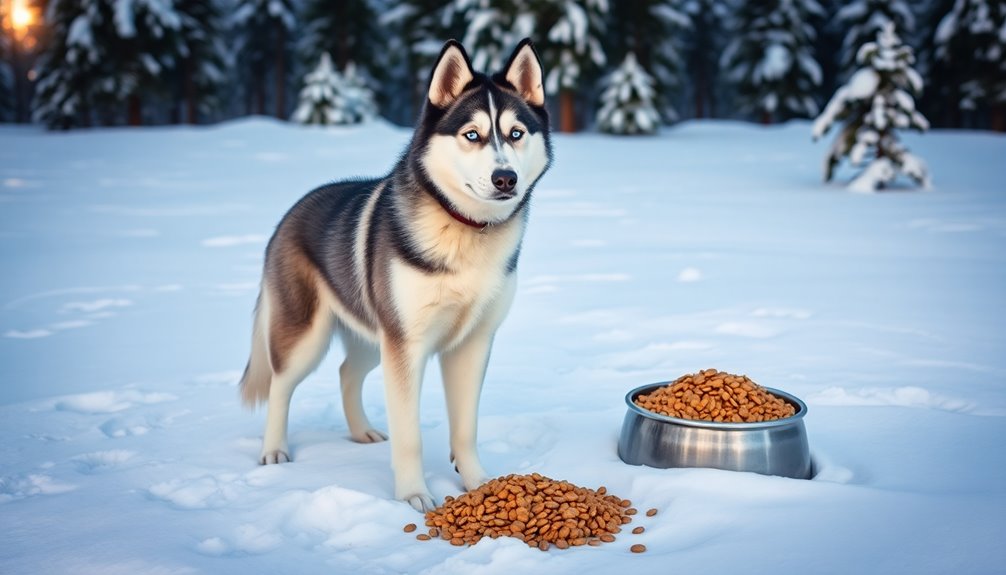
Caring for a Siberian Husky involves understanding their unique grooming needs, exercise requirements, and diet preferences.
You'll need to brush their thick double coat regularly and ensure they get plenty of physical and mental activity each day. Additionally, providing a balanced diet tailored to their energy levels is key to keeping them healthy and happy. Given their high energy levels, it's essential to incorporate at least two hours of exercise into their daily routine to prevent boredom and destructive behavior.
Double Coat Grooming Frequency
Grooming a Siberian Husky's double coat is essential for keeping your dog healthy and comfortable. You should brush your Husky at least 2-3 times a week, but during shedding seasons, increase that to daily. Use a slicker brush and an undercoat rake to effectively remove loose fur and prevent matting. Always brush in the direction of hair growth to avoid causing discomfort, paying special attention to the dense undercoat.
Huskies shed their undercoats completely twice a year, in spring and fall. During these times, you'll need to ramp up your grooming to manage the increased fur. In spring, they shed their heavier coats to prepare for warmer weather, while in fall, they get ready for their denser winter coats. The double coat structure is critical for their insulation and protection against the elements.
Bathing your Husky every 2-3 months is usually sufficient, but you can adjust based on their needs. Over-bathing can strip their natural oils, leading to skin issues, so stick to dog-friendly shampoos designed for Husky coats.
Also, remember that regular dental care and nail trimming are essential to ensure your Husky remains comfortable and healthy.
Exercise requirements and energy levels
For a Siberian Husky, meeting their exercise requirements is crucial to their overall well-being. These energetic dogs need at least 1-2 hours of exercise daily, combining both physical activity and mental stimulation. Daily walks and jogs are essential to help burn off their excess energy. It's important to remember that they thrive on significant exercise, ideally requiring 3-5 miles of activity several times a week to keep them satisfied.
Make sure to incorporate activities like running, hiking, and playing fetch, spreading exercise sessions throughout the day to keep boredom at bay. Engage in high-energy activities like agility training or sledding during colder months.
Interactive games such as fetch and visits to the dog park can provide great socialization opportunities. Mental stimulation is equally important, so consider puzzle toys and obedience training to challenge their minds.
Be mindful of the climate when exercising your Husky. In hot weather, limit exercise to early mornings or late evenings to prevent overheating. During summer, opt for indoor activities in air-conditioned spaces when necessary.
Always monitor for signs of overheating, adjusting your exercise routine based on your dog's age, health, and fitness level. By keeping a close eye on their energy levels, you can ensure your Husky stays happy and healthy.
Feeding tips and diet recommendations
Ensuring your Siberian Husky gets the right nutrition is vital for their health and energy levels. Start with high-quality protein; aim for about 30% for puppies and 25% for adults. Include moderate to high fat—around 20% for puppies and 15% for adults—to support their active lifestyle. Siberian Huskies are known for their ability to work harmoniously in groups, which further emphasizes the need for a well-balanced diet to maintain their energy and teamwork.
Keep carbohydrates low by avoiding wheat, corn, and soy, while ensuring fiber content is about 4% for adults and 7% for seniors.
Feeding schedules matter, too. Feed puppies four meals a day until eight weeks, then three meals until nine months, transitioning to twice daily. For adults and seniors, stick to two meals a day, with portion control based on weight and activity level.
Avoid overfeeding or underfeeding to maintain optimal weight. Choose high-quality protein sources like real meat and natural ingredients, steering clear of artificial fillers.
Consider a raw food diet if you prefer a more species-appropriate option. Monitor your Husky's weight regularly and adjust their diet as needed, especially for seniors.
Always provide access to clean, fresh water to keep them hydrated.
Training and Socialization
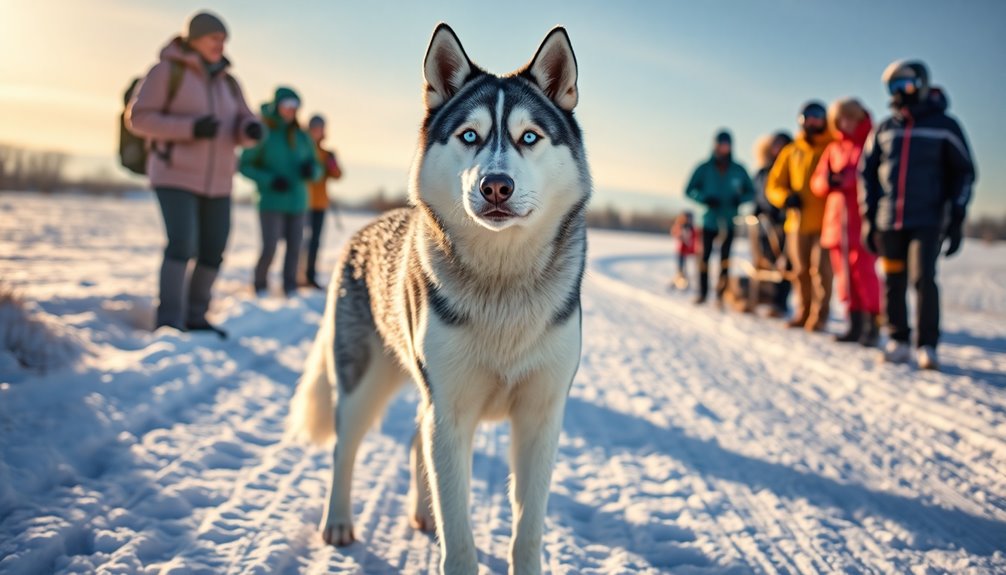
Training your Siberian Husky can be a rewarding challenge, as these dogs are both stubborn and intelligent learners. To set them up for success, introduce new experiences through positive reinforcement, making each lesson enjoyable. Keep an eye on their chewing habits, as they can become destructive if they're not mentally stimulated or properly redirected. Early socialization with other dogs is essential for a puppy's healthy development, so consider scheduling playdates with vaccinated pups.
Stubborn yet Intelligent Learners
Siberian Huskies are known for their impressive intelligence, but this often comes hand-in-hand with a stubborn streak that can make training a challenge.
These dogs were originally bred as sled dogs, giving them a strong work ethic and abundant energy. However, their independent nature means they may not always feel inclined to listen to you. Research shows that pet therapy can enhance emotional well-being, which may indirectly support a more positive training environment.
To train your Husky effectively, consistency is crucial; they don't understand 'sometimes.' Use positive reinforcement techniques like treats and praise to encourage good behavior. Incorporating daily exercise into their routine will help channel their energy and improve focus during training sessions.
Establish a regular training routine to reinforce commands, ensuring that you're clear about your expectations. Avoid excessive punishment, as this can harm your relationship with your dog.
Socialization is equally important; exposing your Husky to various environments, people, and other animals during their early weeks is essential for a well-adjusted adult dog.
Basic obedience commands should be taught using motivation like treats or toys. Consider enrolling in obedience classes to keep your Husky engaged and active.
Introduce Through Positive Experiences
Creating positive experiences for your Husky during training and socialization is essential for their development. Start as soon as your puppy comes home, ideally around 8 weeks old. The critical period for socialization is between 3 and 14 weeks, so daily interactions are key.
Gradually expose your Husky to various environments—parks, busy streets, and different surfaces like grass and gravel. This helps them feel more comfortable in new situations. Incorporating themed activities that reflect their interests can also enhance their engagement during training.
Introduce your pup to various people, including children and adults, while rewarding gentle interactions with treats and praise. Arrange playdates with well-socialized dogs to boost their confidence and social skills. Enrolling in obedience classes can also provide valuable socialization opportunities. Additionally, fostering vital social skills during these formative weeks will greatly enhance their ability to navigate adult life successfully.
Always use positive reinforcement techniques to make each encounter enjoyable. Controlled interactions are crucial to ensure your Husky feels safe.
Regularly handle their paws, ears, and mouth to prepare them for grooming. Lastly, expose them to moving or sudden objects to prevent skittishness.
Destructive Chewing Tendencies
Destructive chewing can be a major challenge for Husky owners, often stemming from various underlying causes. These energetic dogs require plenty of physical and mental stimulation; without it, boredom can drive them to chew on furniture or shoes.
If your Husky shows signs of separation anxiety—like panting or trembling—they might chew when left alone. Additionally, chewing is instinctive, helping them relieve stress and explore their environment.
To manage this behavior, supervise your Husky and redirect them to appropriate chew toys when they start chewing the wrong items. Offering a variety of toys, such as stuffed KONGs and Nylabones, can keep them occupied.
Consistent training is essential, so make sure everyone in your household uses the same commands. Teach the "Leave it" cue and reward them for engaging with their toys instead of your belongings.
Increasing physical exercise and mental stimulation through interactive games or obedience training can help curb destructive chewing. Engaging in structured activities that satisfy their high energy levels will also reduce the likelihood of chewing on inappropriate items.
Lastly, evaluate your home for tempting items and consider seeking professional help if chewing persists. With patience and proper training, you can guide your Husky towards appropriate chewing habits.
Ideal Living Environment
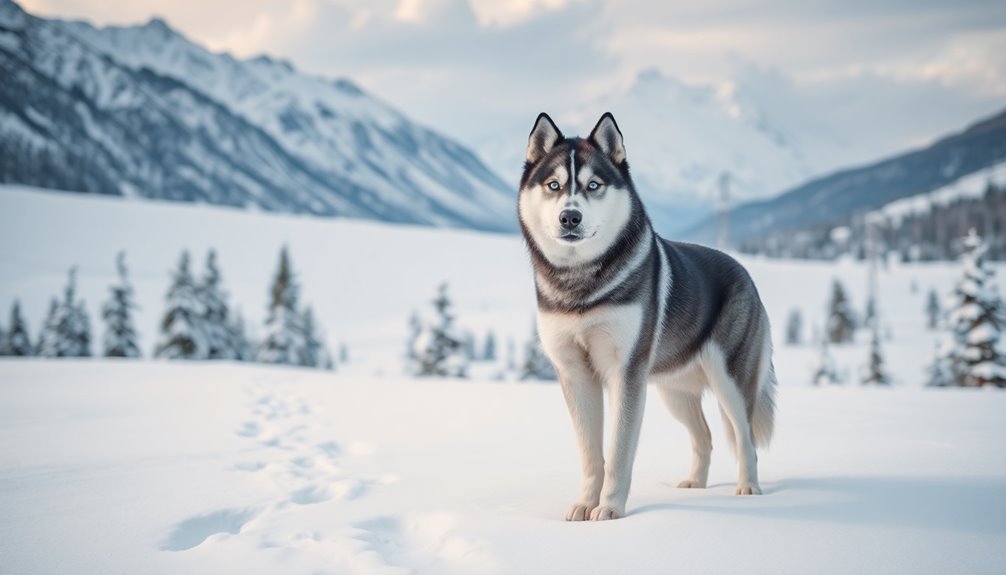
If you're considering a Siberian Husky, a spacious fenced backyard is ideal for their energetic nature. They thrive in cold weather, so having access to outdoor spaces where they can play and explore is crucial. Additionally, their friendly and outgoing personality makes them great companions for families who enjoy outdoor activities.
Spacious Fenced Backyard Preferred
While a spacious fenced backyard isn't just a luxury for Siberian Huskies, it's essential for their well-being. These energetic dogs need a securely enclosed yard, ideally surrounded by at least a six-foot privacy fence. Regular chain link fences won't do, as Huskies are skilled climbers. To prevent digging, make sure the fence is buried at least a foot underground, and consider adding concrete slabs or anti-digging measures.
Huskies are notorious escape artists, so a high, sturdy fence is crucial to keep them contained. Regularly check your fence's integrity to catch any potential breaches before they happen. You'll also want gates that are just as tall, with automatic closures or locking mechanisms to ensure they stay shut.
In your spacious backyard, designate areas for exercise, such as running or digging, which can help channel their energy positively. Daily, Huskies require at least one to two hours of exercise combined with mental stimulation to keep boredom at bay. Because of their need for cold-weather precautions, it's important to ensure they have access to shade and water during warmer months.
A home with a yard where they can run freely, along with plenty of human interaction, creates the ideal environment for your Husky to thrive.
Cold Weather Adaptability
A spacious fenced backyard provides the perfect setting for your Siberian Husky's playful energy, but it's their remarkable cold weather adaptability that truly sets them apart as a breed.
With thick, double-layered coats, Huskies are built for the cold. The undercoat retains body heat, while guard hairs repel water and trap warmth. Their furry paws act like natural snow boots, offering both insulation and traction in icy conditions. This unique adaptation allows them to navigate snowy terrains with ease, ensuring their snow-ready paws stay warm and protected.
Behaviorally, Huskies curl up into a ball to conserve heat, tucking their noses between their hind legs to breathe in warmer air. They can withstand temperatures down to -60 degrees Fahrenheit, making them comfortable in frigid environments.
However, while they thrive outdoors, you'll need to provide them with proper shelter and nutrition to prevent hypothermia and frostbite.
Regular brushing is essential to manage their shedding, especially during seasonal changes. Also, keep an eye on their caloric intake, as they may need more food in the cold.
Howling Communicates With Pack
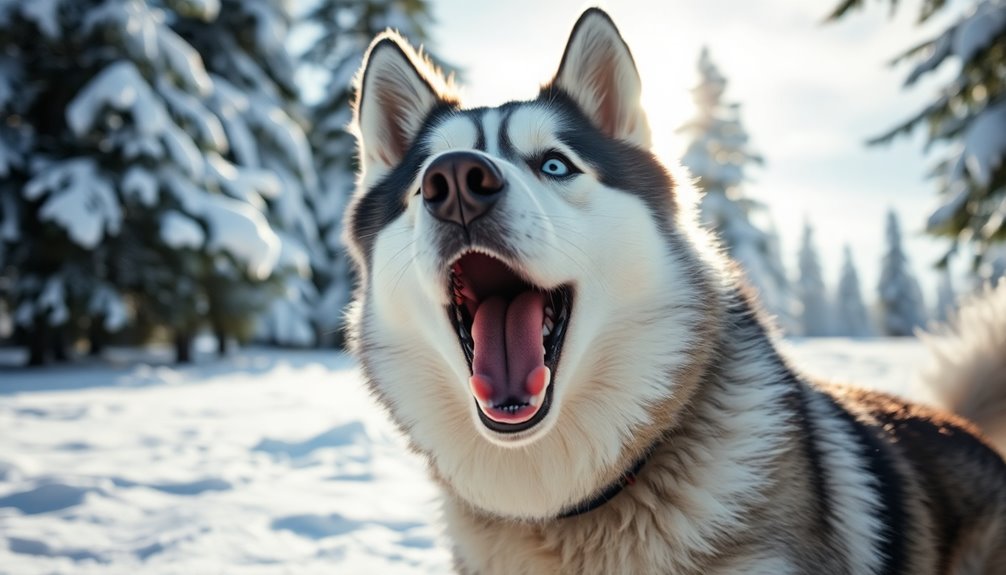
When you hear a Siberian Husky howl, it's much more than just noise; it's a form of communication that goes beyond typical barking. These vocalizations help them connect with their pack, whether it's to express needs or alert others, as seen in Balto's legendary 1925 serum run. Understanding this unique form of communication can deepen your bond with these stunning sled dogs. Howling serves as a vocalization method for expressing emotions and maintaining pack cohesion, showcasing their rich social behavior.
Vocalizations Beyond Typical Barking
Understanding how your Siberian Husky communicates through howling can deepen your bond with them. Howling isn't just noise; it's an essential part of their instinctual behavior. Your Husky may howl to gather the pack, signaling their location when they feel separated from you or other dogs. This vocalization also expresses emotions, whether it's excitement, boredom, or anxiety.
As a pack animal, your Husky uses howling to maintain social bonds. You might notice them howling in response to external sounds like sirens or musical instruments, tapping into their wolf ancestry. Loudness is a breed trait, meaning that your Husky's vocalizations are inherent and not easily altered.
If left alone for too long, howling can indicate separation anxiety, loneliness, or even health issues. Huskies also exhibit a variety of vocalizations beyond howling, including talking and whining. They often engage in a call-and-response behavior, responding to your sounds or other dogs' vocalizations.
Over time, you'll learn the unique meanings behind their howls, helping you understand what they want or need in different contexts. This connection enriches your relationship and enhances your Husky's well-being, allowing both of you to communicate more effectively.
Balto's 1925 Serum Run
Howling plays a vital role in the history of Siberian Huskies, especially during the heroic events of Balto's 1925 Serum Run. When a diphtheria epidemic threatened the children of Nome, Alaska, the expired antitoxin supply couldn't keep up. With harsh weather making air delivery impossible, dog sled teams became the only option to transport the much-needed serum.
Led by Balto and musher Gunnar Kaasen, the final 55 miles of the 674-mile journey showcased the strength and resilience of Huskies. Togo, under Leonhard Seppala, tackled the longest and most perilous stretch of 261 miles, crucial to the overall success. The use of mushers and sled dogs in this run exemplified the incredible teamwork necessary to overcome the challenges presented by nature. Heat pumps can also play a significant role in providing warmth during harsh climates, similar to how these dogs were essential for survival in extreme conditions.
The entire relay involved 20 mushers and around 150 sled dogs, battling temperatures that often plunged below -40 °C (-40 °F) and navigating through fierce blizzards. The serum was exchanged multiple times between teams, but they persevered.
Balto and Kaasen received national acclaim and a hero's welcome upon arrival. Statues honoring Balto stand in Central Park and Anchorage, serving as lasting testaments to the remarkable bond between Huskies and their mushers, a bond strengthened by their howling communication.
Active Lifestyle Compatibility
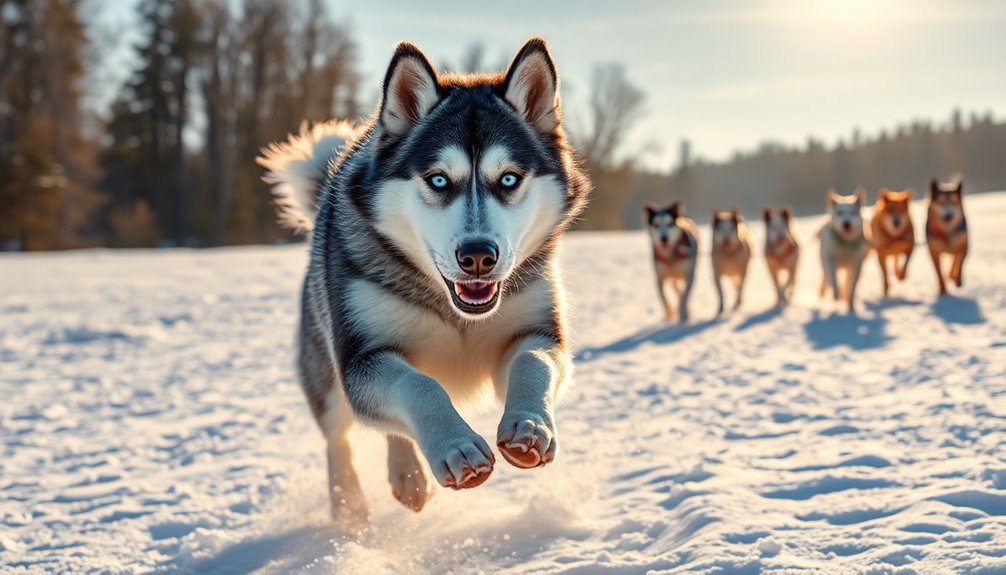
If you're considering bringing a Siberian Husky into your home, be prepared for a high exercise commitment. These energetic dogs need at least two hours of activity each day, along with time for training and socialization. An active lifestyle is essential for their happiness and well-being, so make sure you're ready to keep up with their needs. Regular exercise not only supports their energy levels but also promotes joint and bone health, reducing the risk of common issues in larger breeds.
High Exercise Commitment Required
For anyone considering bringing a Siberian Husky into their home, it's essential to recognize the high exercise commitment these dogs require. Huskies need at least 1 to 2 hours of physical activity each day, which translates to three to five miles of exercise at least four days a week. Daily walks, runs, and engaging activities are crucial to burn off their abundant energy.
Ideal exercises include brisk walking, running, hiking, and even participating in sports like agility training or sledding. Since Huskies have a pack mentality, interactive play with other dogs fulfills their social needs. Structured activities, such as leash walks and playtime at dog parks, should be part of your routine. Regular exercise is vital; Huskies need daily activity to prevent boredom and destructive behavior.
Keep in mind that temperature affects exercise duration; above 65ºF (18ºC), limit sessions, while they thrive in colder weather. Regular exercise not only keeps them fit but also prevents obesity and behavioral issues.
It's important to provide mental stimulation too, through puzzle toys or obedience training. A balanced routine helps maintain their health and happiness, ensuring your Husky remains the energetic companion you desire.
Time Commitment for Training
Owning a Siberian Husky means committing significant time to training, which is just as important as their exercise needs. Start training your Husky as soon as they come home, usually around 8 weeks old.
Crate training is essential; it not only secures your pup but also gives them a safe space to retreat. Establish a consistent schedule for feeding, potty breaks, and play to nurture good habits.
Enroll in obedience classes by 10-12 weeks, ensuring your pup is fully vaccinated. Socialization with various people and environments is crucial to prevent antisocial behaviors. Regular exercise is vital for overall well-being, so ensure that your training sessions incorporate physical activity to keep your Husky engaged.
For the first year, keep your dog engaged in continuous training classes and introduce dog sports like agility and sledding as early as four months. This helps channel their energy effectively.
Frequently Asked Questions
How Much Exercise Do Siberian Huskies Need Daily?
Siberian Huskies need at least 1 to 2 hours of exercise daily.
You can spread this time throughout the day to keep them engaged and prevent boredom. Activities like brisk walks, running, and interactive games are crucial for their physical and mental health.
Make sure to include varied exercises like hiking or agility training, and don't forget to monitor the weather to ensure their safety during outdoor activities.
Are Siberian Huskies Good With Children and Other Pets?
Yes, Siberian Huskies can be good with children and other pets if they're well-socialized and trained.
You'll need to supervise interactions, as their playful nature can unintentionally knock over small kids. Teach children how to interact respectfully to avoid any defensive reactions.
Huskies generally get along with other dogs but may chase smaller pets due to their prey drive.
Consistent training and socialization are crucial for harmonious relationships in your home.
What Grooming Needs Do Siberian Huskies Have?
When it comes to grooming needs, you'll want to brush your dog's coat at least once a week to prevent tangles and matting.
During shedding seasons, daily brushing is ideal.
Bathe them every few months or when they get dirty, using a gentle dog shampoo.
Regularly trim their nails and maintain dental hygiene with daily brushing.
Don't forget to check for fleas and ticks, and keep their ears and eyes clean for optimal health.
How Do I Prevent Siberian Huskies From Escaping My Yard?
To prevent your husky from escaping your yard, install a secure fence at least 6 feet tall and bury it 12 inches underground.
Use inward-facing slants at the top to deter climbing. Provide plenty of physical and mental stimulation to keep them engaged, and never leave them unsupervised for long.
Train them with recall commands and consider using GPS collars for added security.
Regularly check your yard for potential escape routes.
What Are Common Behavioral Issues in Siberian Huskies?
Common behavioral issues in dogs often stem from high energy levels, leading to destructive behaviors like chewing or digging.
If they don't get enough exercise, you might notice excessive barking or restlessness.
Separation anxiety can also create problems, like panting or eliminating indoors when left alone.
Additionally, vocalization can signal emotional distress.
Consistent training and plenty of physical activity are essential to manage these behaviors effectively and keep your dog happy.
Conclusion
In conclusion, the Siberian Husky is more than just a stunning sled dog; it's a lively companion that thrives on activity and social interaction. With their rich history and unique personality, these dogs bring joy and energy to any home. If you're ready to embrace their spirited nature and provide the right environment, a Husky can become a loyal and adventurous part of your life. Just remember, they'll need plenty of exercise and love!

